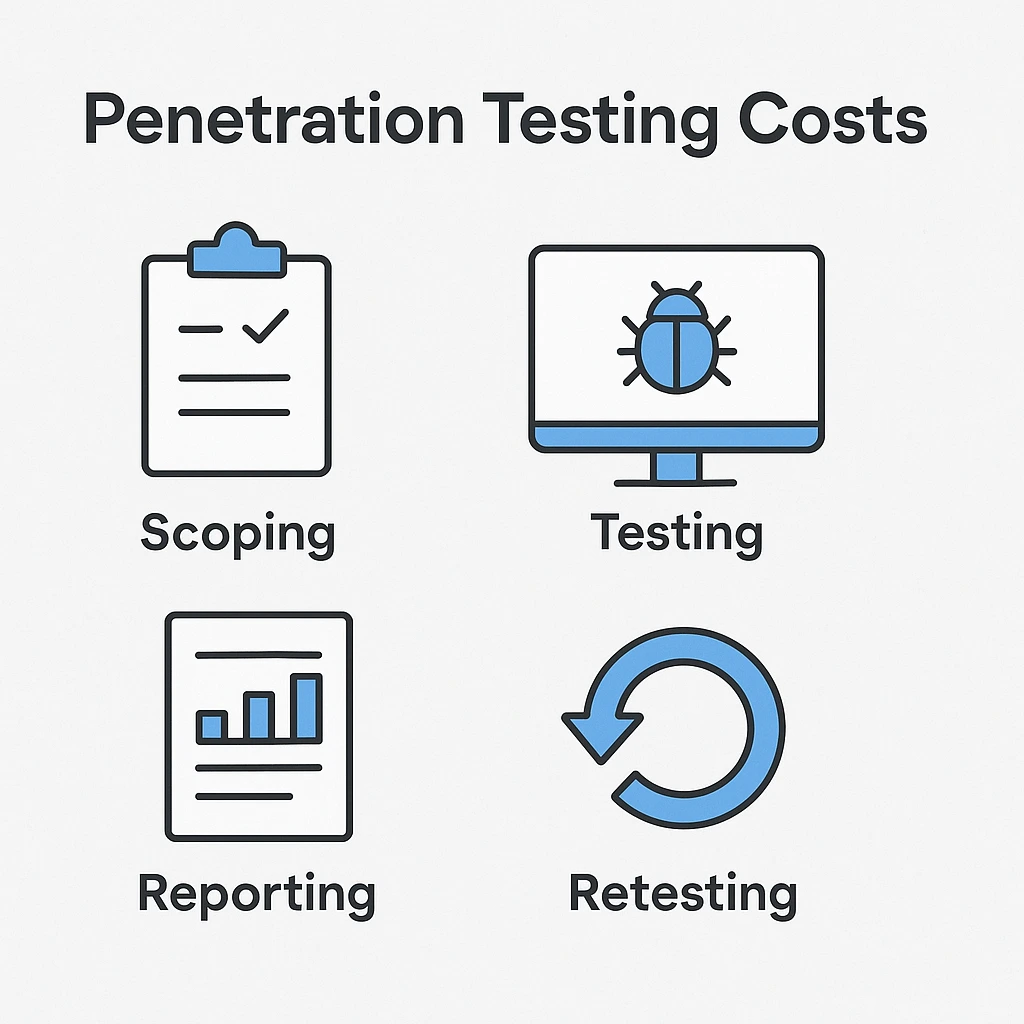
When evaluating how much penetration testing costs, clients should expect a breakdown of what is included in the price. The engagement typically begins with scoping and a pre-engagement questionnaire that defines the rules of engagement, data handling, and acceptable testing windows. This upfront work ensures legal and operational safety and helps set realistic expectations for risk, duration, and deliverables.
In most proposals, the cost covers project management, testers' time, infrastructure, and the tools needed to perform the assessment, whether conducted on-site or remotely.
The actual testing portion encompasses discovery, vulnerability identification, and manual and automated techniques designed to emulate real-world attackers. A comprehensive report, with an executive summary, risk ratings, findings, evidence, and remediation guidance, is usually included or offered as a standard deliverable. Many firms also include retesting or remediation verification to confirm fixes have been applied effectively.
Costs are driven by scope, complexity, and depth: the number of assets, the mix of external and internal tests, the types of systems involved (web apps, APIs, mobile apps, networks, cloud). Additional factors include engagement length, testing windows, travel for on-site assessments. Understanding these drivers helps you compare proposals fairly and negotiate a pricing model: fixed-price or time-and-materials that aligns with your security program and budget.
Prices for penetration testing vary widely, and understanding why helps you judge value rather than chase the lowest quote. The most important factor is scope: the number of systems, networks, and applications to test, plus whether you need web, API, mobile, or internal assessments.
A larger, more complex scope requires more time, tools, and specialized testers, which increases cost. Another driver is the depth of testing: a basic vulnerability scan differs from a full manual pentest assessment. The quality of deliverables matters as well. Reports that translate findings into practical fixes, prioritized risk, and actionable remediation steps take more effort to produce.
Engagement model and schedule also influence price. Fixed-scope engagements with well-defined boundaries are cheaper per hour than ongoing engagements or retainer-based services. Also, urgency imposes a premium. Urgent tests to meet deadlines may incur expedited timelines.
The tester's experience and reputation matter as well. Firms with seasoned consultants or cross-domain expertise charge higher rates but typically deliver faster, more reliable results. Geography and delivery method matter too. On-site assessments incur travel costs, while remote testing requires secure access and robust collaboration tools.
Pricing for security testing comes in a few common, easy-to-understand options. The right choice depends on your project’s scope, risk, and urgency.
For example. at Pentest King we have 2 different
- Point-in-Time Penetration Test: Executed once a year. Ideal for companies that go after compliance such as SOC 2, HIPAA or PCI-DSS.
- Continuous Penetration Test: Executed quarterly, 4 times a year. Ideal for companies that constantly deploy new features and need to maintain high security posture.
Penetration tests can be billed in the following manner:
- Fixed-price: You and the provider agree on a defined scope and the exact deliverables.
Budgets are straightforward when requirements are clear and your environment is stable.
- Time-and-materials: You pay for the actual days, testers, and tools used.
This is flexible if requirements may change, your network is complex, or you are dealing with regulatory needs.
- Retainer: A pre-purchased block of testing hours or ongoing access to security experts.
This is convenient for ongoing assurance and quick responses to new threats.
In short, fixed-price is best for well-defined projects, time-and-materials fits changing or complex environments, while retainer suits ongoing security needs.
When answering how much penetration testing costs, the most influential variable is scope. The number of assets, types of systems, applications, and data in scope drives labor hours and tooling needs.
External tests focusing on internet facing assets tend to cost less than internal or hybrid assessments that simulate realistic attacker paths. A simple web application with a single frontend and standard authentication might fall in a lower price band, while multiple application environments with APIs, microservices, and complex integrations push the cost up.
Other critical factors include the testing depth and compliance requirements. Tools, manual techniques, and expertise level of testers also influence price; seasoned teams may justify higher fees for higher risk scenarios. Geographic location of the vendor can affect rates due to market norms and cost of living. Scheduling, repeated testing cycles, and the need for validation testing after remediations add to the total.
To obtain a reliable estimate, request a proposal that itemizes assets, methodologies (e.g., OWASP Top 10, ASVS), and deliverables. In general, expect a range: smaller, scoped engagements may be a few thousand dollars ($3.000-$5.000), midsize projects in the tens of thousands, and large enterprise assessments well into six figures when extensive coverage, regulatory alignment, and long term risk management are required.